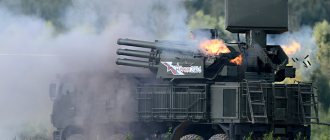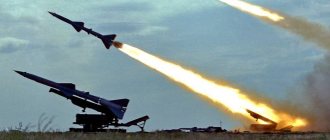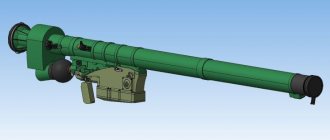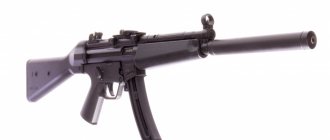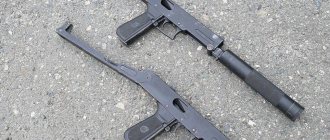The second half of the last century was a time of rapid development of combat aviation. Aircraft became faster and received new types of weapons and targeting systems. Combat helicopters appeared, at first they were clumsy and slow machines, suitable only for transporting goods and wounded soldiers, but very quickly they became formidable attack machines. As a result, it was the threat of air attack that became the most dangerous for modern ground forces.
The history of several local conflicts at the end of the last and beginning of this century has shown that aviation is capable of deciding the fate of an armed conflict. The emergence of high-precision air-to-ground missiles, new fire control systems, and the rapid development of unmanned aerial vehicles only strengthen the role of aviation. According to most military experts, in this century it is aviation that will become the queen of the battlefield.
What about the ground forces? How can they counter the threat from the air? How can they protect themselves? In recent decades, many leading countries have been actively developing short- and medium-range anti-aircraft missile systems designed to protect troops and infrastructure.
These air defense (air defense) systems make it possible to most effectively fight against maneuverable and low-flying air targets, including front-line aviation (including attack helicopters) and cruise missiles.
In 1990, Russia began developing a new short-range anti-aircraft missile and gun system (ZRPK) “Pantsir-S1”; it was created to protect ground forces units and critical industrial facilities.
History of the creation of the Pantsir-S1 air defense missile system
In the mid-60s, the legendary Soviet anti-aircraft gun ZSU-23-4 “Shilka” was created. However, already in the mid-70s it became clear that this complex was already obsolete. The 23 mm gun could not effectively hit high-speed and well-protected air targets. Radar equipment also did not meet the requirements of the time.
At the end of the 70s, the development of a fundamentally new anti-aircraft complex began, which was supposed to cover ground forces. The new air defense system received a more powerful 30-mm cannon and a missile system for more effective combat against enemy helicopters. In 1982, the new Tunguska air defense missile system was put into service.
The development of the Tunguska air defense system was carried out by the Tula Instrument Design Bureau. The 30-mm cannon of this air defense missile system can fire at low-flying targets. However, the Tunguska could only use its missile weapons during stops and in conditions of visual contact with an air target.
According to its characteristics, the Tunguska air defense system was undoubtedly a new step in protecting ground forces from enemy aircraft. In the mid-80s, military aviation itself began to change rapidly. Cruise missiles and unmanned aerial vehicles operating at low and ultra-low altitudes appeared, and new high-precision weapons and electronic warfare (EW) equipment were actively developed.
Analysis of previous conflicts clearly showed that aviation tactics will be based on the use of high-precision weapons, which should completely suppress enemy air defenses. To counter such tactics, it was necessary to train the air defense system to effectively counter precision weapons.
It is obvious that the Tunguska air defense system could no longer effectively perform its functions, and in 1990 the development of a new air defense system began, capable of meeting the challenges of the time. The creation of the new complex was entrusted to the Tula Instrument Design Bureau. The new air defense missile system was given the following tasks: protection of mobile units of the ground forces, important military and economic facilities. In addition, the air defense system was supposed to protect air defense systems with a long range (for example, S-300).
The new anti-aircraft missile and gun system was named “Pantsir-S1”. In 1994, the first prototype of this machine was ready.
At first, the military did not show much interest in the new anti-aircraft complex. “Pantsir-S1” did not know how to shoot while moving, and according to the military, it could not successfully fight high-precision weapons at a range of more than 12 kilometers. The army was not satisfied with his characteristics. Given the difficult economic situation in the early 90s, the car was forgotten for a while.
But then chance intervened in the fate of the car. The Russian air defense system was of great interest to the UAE military, but they demanded qualitatively different characteristics, and Tula designers had to radically remake the complex. The vehicle was equipped with new cannon armament, more advanced anti-aircraft missiles that could hit targets at a distance of twenty kilometers, and the radar and fire control system (FCS) were seriously changed. We can say that Pantsir-S1 has experienced a rebirth, becoming a much more advanced and formidable machine. Tests of the new version took place in 2006.
The amount of the export contract was $734 million. But due to the fault of the contractors, the contract terms were missed, and the first complexes were delivered to the UAE only in 2009.
Then there was a contract with Algeria worth $500 million. 38 complexes were made for this country. Pantsir-S1 was also purchased by Syria, Oman, Brazil, Iran and Iraq. This complex was officially adopted by the Russian army in 2012. They plan to replace all Tunguska air defense systems with it. A modification of the complex, Pantsir-S2, should appear in 2022, and a year later a new version that can combat ballistic missiles. A ship modification of the complex is expected to appear in 2022; its exact characteristics are still unknown.
According to unverified information, the cost of one Pantsir-S1 air defense system ranges from 13.15 to 14.67 million dollars.
By the end of 2014, 36 anti-aircraft missile systems of this type were delivered to the Russian army.
Modifications of Pantsir-S
Novel - 1994. The prototype is made on the Ural-5323-20 chassis.
ZPRK 96K6 - 2005. Serial version, made on the KamAZ-6560 chassis.
Pantsir-S1-O - 2005. Armament: 2x2 30mm 2A72, 2x4 57E6E. With an optical weapon control system (with a single-purpose channel). There is no tracking radar.
Pantsir-S1E is a modification for export purposes, made on the MAN-SX45 chassis. Foreign-made equipment was used. SAM - 9M311;
Pantsir-2E - 2006 - a special model for export purposes. Tracking radar with improved parameters;
Pantsir-S1 - 2006. Armament: 2x2 30-mm 2A38M, 2x6 57E6E. With a tracking radar with a 4-target channel, the target acquisition zone is 0.2-20 km in range and 0-15 km in altitude.
Pantsir-S1 (BM 72V6E) - Modification of the complex, made on the BAZ-6909-019 chassis.
Pantsir-S2 is a modernized complex for the Russian Armed Forces, in service.
Pantsir-M is a naval version of the Pantsir-S air defense missile system. It was planned to begin mass production from July 2015. In August 2015, an order was placed for the first three complexes, and on April 30, 2018, the first MRK of Project 22800, equipped with the complex, was launched.
Pantsir-ME - 2015. Armament: 8 ready missiles + 32 in reserve, 2x6 30 mm cannons. Offered for export. The complex should replace Dirk and some ships will be modified for it.
Pantsir-SA is an Arctic modification based on the DT-30 two-link tracked transporter. It was first presented to the general public at the Victory Parade on Red Square on May 9, 2022. Unlike the base model, there is no anti-aircraft gun, the number of missiles has been increased from 12 to 18, and the target detection station has been modernized.
Pantsir-SM is a modification in which, through the use of a newly developed multifunctional aiming station, the target engagement range is increased to 40 km, and the detection range is 75 km.
ZRPK "Pantsir-S1" based on KamAZ-6560
Capabilities of Pantsir-S1
The Pantsir-S1 air defense missile system is a universal means of combating air targets with speeds of up to 1000 m/s at a distance of 200 to 20 thousand meters. The complex can destroy air targets at altitudes from 5 to 15 thousand meters. He can also fight enemy light armored vehicles and manpower. This complex can almost instantly detect and destroy an enemy aircraft, helicopter, cruise missile or guided bomb.
“Pantsir-S1” can be placed on a wheeled or tracked chassis; stationary installation is also possible. The complex has a communication system protected from interference.
The destruction of air targets is carried out using cannon weapons and anti-aircraft missiles with infrared and radar seekers.
Each vehicle has three locators: an early warning and target designation radar, a tracking and guidance radar, and a passive optical radar.
The target detection radar can simultaneously track up to twenty objects and transmit their coordinates and speed data to the on-board computer. In addition, this radar determines the type of target and its nationality.
The radar for tracking targets and missiles largely determines the high efficiency of the complex. It is equipped with a phased array antenna. The radar allows the air defense missile system to fire at three targets at once, while a salvo of two missiles is possible at the most dangerous of them.
The optical-electronic system (OES) is used to fire at low-flying targets, as well as ground targets.
“Pantsir-S1” can conduct targeted fire while moving, which is beyond the capabilities of foreign analogues of this complex. This allows the vehicle to more effectively cover convoys of equipment from airstrikes.
The armament of the complex consists of two twin 30-mm 2A38M anti-aircraft guns with a firing range of four kilometers and 12 57E6 guided anti-aircraft missiles (SAM), located in two blocks on each side of the combat module.
The 57E6 missile is very similar in appearance to the Tunguska missile defense system. The rocket is bicaliber, the engine is in the second stage. It has high maneuverability, a small acceleration section, and two fuses: contact and non-contact. The mass of the warhead is 20 kilograms, the striking elements are of the rod type. The rocket's upper stage is fired at the initial stage of flight.
The Pantsir-S1 complex can be used in several modes:
- Autonomous work. The complex can work independently: detect targets, aim and direct missiles at selected air targets
- Group fighting. The complex can consist of batteries, each of which includes six vehicles. A special coded connection is established between them. Each complex works for its own purposes without interfering with others
- Work under the control of an external command post. In this case, the vehicles receive target designations from the command post and subsequently carry out all stages of work independently.
Each of the vehicles in this complex can serve as a command post.
Technical characteristics of the Pantsir-S1 air defense missile system
| Ammunition: – SAM on launcher – rounds | 12 1400 |
| Damage zone, m: – missile weapons (range) – missile weapons (height) – cannon weapons (range) – cannon weapons (height) | 1200-20000 10-15000 200-4000 0-3000 |
| Response time, s | 4-6 |
| Number of people in the combat crew | 3 |
| Speed of targets hit, m/s | 1000 |
| Productivity, targets fired per minute | 8-12 |
| Detection and target designation station 1RS1 | |
| Target detection range with EPR 2m2, km | 36 |
| Range of radial velocities of detected targets, m/s | 30-1000 |
| Viewing area: – in azimuth, degrees – in elevation, degrees | 360 0-60; 0-30; 40-80; 0-25 |
| Zone review period, s | 2; 4 |
| Number of simultaneously tracked targets | 20 |
| Operating range | S |
| Target and missile tracking station | |
| Work area: – in azimuth, degrees – in elevation, degrees | ±45 -5 to +85 |
| Maximum target detection range, km: – with EPR = 2m2 – with EPR = 0.03m2 | 24 7 |
| Simultaneous automatic tracking of: – targets – missiles | up to 3 to 4 |
| Operating range | TO |
| Anti-aircraft guided missile 57E6-E | |
| Weight, kg – in container – starting – warhead | 94 74,5 20 |
| Caliber, mm – launch stage – sustainer stage | 170 90 |
| Rocket length, mm | 3160 |
| TPK length, mm | 3200 |
| Maximum rocket speed, m/s | 1300 |
| Average flight speed, m/s: – at 12 km – at 18 km | 900 780 |
| Automatic 2A38M (double-barreled) | |
| Caliber, mm | 30 |
| Quantity | 2 |
| Projectile weight, kg | 0,97 |
| Projectile speed, m/s | 960 |
| Rate of fire | 1950-2500 |
| Shooting control method | remote |
| Possibility of operation, °C | ±50 |
Rocket and gun designer
"Shell" has a modular design. This solution significantly saves time for repairing the complex, and at the same time simplifies its modernization. So, if a shell fragment hits a combat vehicle, then it will be enough to just remove the affected block and install a new one in its place. The same manipulations with the modules can be done after our military-industrial complex develops more modern means of detecting targets and other important components of the air defense system.
See also: Comparative characteristics of “Topol-M” and “Minuteman-3”. Infographics

